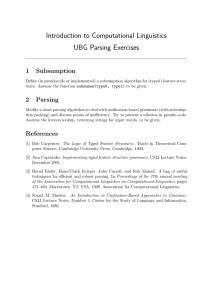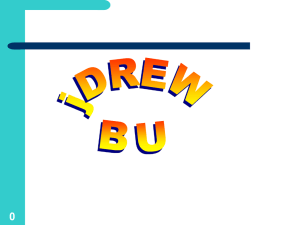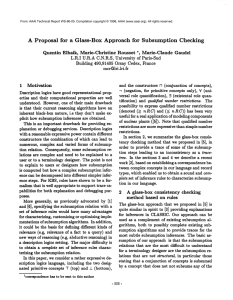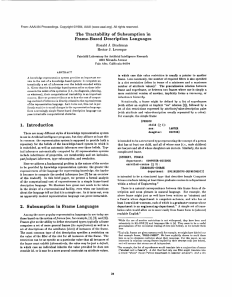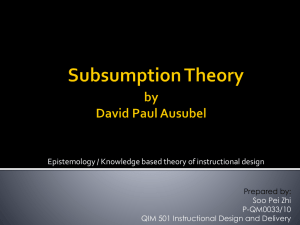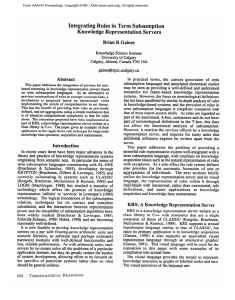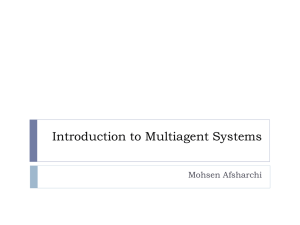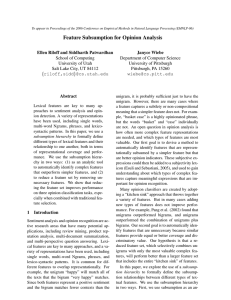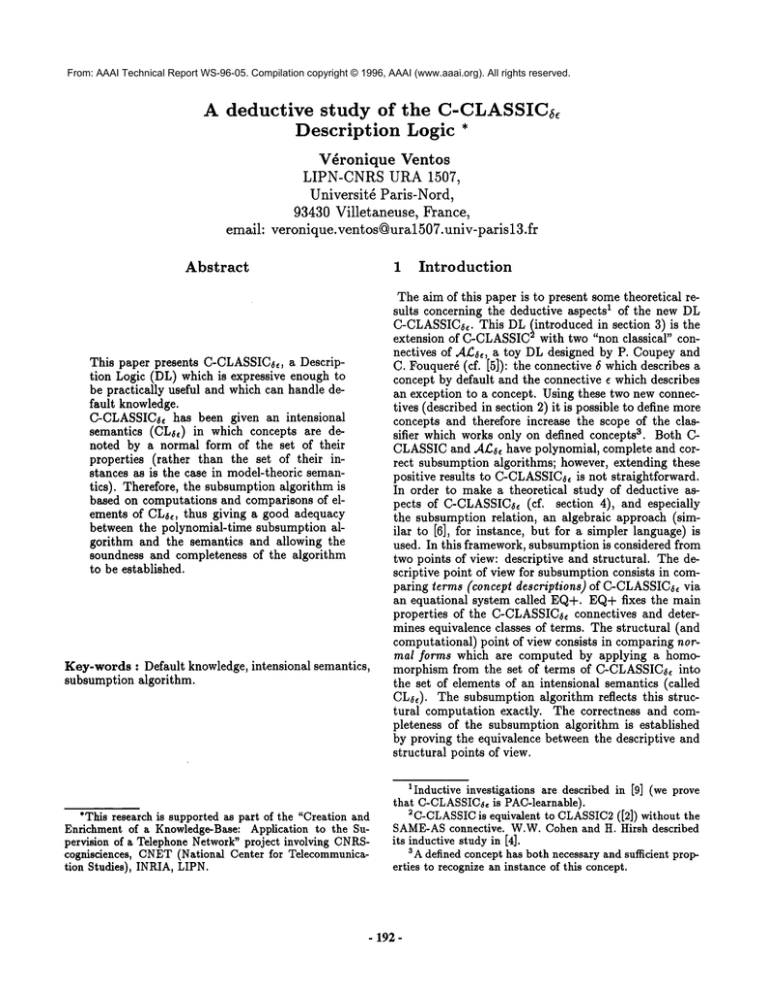
From: AAAI Technical Report WS-96-05. Compilation copyright © 1996, AAAI (www.aaai.org). All rights reserved.
A deductive
study of the C-CLASSIC
Description Logic *
V~ronique Ventos
LIPN-CNRS URA 1507,
Universit~ Paris-Nord,
93430 Villetaneuse, France,
emaih veronique.ventos@ura1507.univ-paris 13.fr
Abstract
1
This paper presents C-CLASSIC~e,a Description Logic (DL) which is expressive enough
be practically useful and which can handle default knowledge.
C-CLASSIC6~has been given an intensional
semantics (CL6e) in which concepts are denoted by a normal form of the set of their
properties (rather than the set of their instances as is the case in model-theoric semantics). Therefore, the subsumption algorithm is
based on computations and comparisons of elements of CL~, thus giving a good adequacy
between the polynomial-time subsumption algorithm and the semantics and allowing the
soundness and completeness of the algorithm
to be established.
Key-words: Default knowledge, intensional
subsumption algorithm.
semantics,
Introduction
The aim of this paper is to present sometheoretical results concerning the deductive aspects 1 of the new DL
C-CLASSIC~e.This DL (introduced in section 3) is the
s with two "non classical" conextension of C-CLASSIC
nectives of .ALoe, a toy DL designed by P. Coupey and
C. Fouquer~(cf. [5]): the connective ~ which describes
concept by default and the connective e which describes
an exception to a concept. Using these two new connectives (described in section 2) it is possible to define more
concepts and therefore increase the scope of the classifter which works only on defined concepts 3. Both CCLASSICand .AL:~ have polynomial, complete and correct subsumption algorithms; however, extending these
positive results to C-CLASSIC~
is not straightforward.
In order to make a theoretical study of deductive aspects of C-CLASSIC,c(cf. section 4), and especially
the subsumption relation, an algebraic approach (similar to [6], for instance, but for a simpler language) is
used. In this framework, subsumption is considered from
two points of view: descriptive and structural. The descriptive point of view for subsumption consists in comparing terms (concept descriptions) of C-CLASSIC~
via
an equational system called EQ+. EQ÷ fixes the main
properties of the C-CLASSIC6econnectives and determines equivalence classes of terms. The structural (and
computational) point of view consists in comparing normal forms which are computed by applying a homomorphism from the set of terms of C-CLASSIC~into
the set of elements of an intensional semantics (called
CL6e). The subsumption algorithm reflects this structural computation exactly. The correctness and completeness of the subsumption algorithm is established
by proving the equivalence between the descriptive and
structural points of view.
l Inductive investigations are described in [9] (we prove
that C-CLASSIC6~
is PAC-learnable).
*This research is supported as part of the "Creation and
2C-CLASSIC
is equivalent to CLASSIC2
([2]) without the
Enrichmentof a Knowledge-Base: Application to the SuSAME-AS
connective. W.W.Cohen and H. Hirsh described
pervision of a Telephone Network"project involving CNRS- its inductive study in [4].
cognisciences, CNET(National Center for Telecommunica3Adefined concept has both necessary and sufficient properties to recognizean instance of this concept.
tion Studies), INRIA,LIPN.
- 192-
2
Overview of the connectives
6 and c
This section is a description of the connectives 6 and e
introduced by P. Coupey and C. Fouquer4 in the ~lL~6~
DL(cf [5]).
The connective 6 intuitively represents the commonnotion of default.
Ex4: Mammal-Animal 17 6Viviparous [q Vertebrate
defines the Mammalconcept as a Vertebrate Animal
which is usually Viviparous. Instances of Mammalnecessarily have the properties Animal and Vertebrate but
they may not have the property Viviparous. Unfortunately, using this definition of Mammal
we can infer that
- for instance - a Duck (Duck - Animal ~ Oviparous rq
Vertebrate I"1 With.beak I"1 QuackI"1 PalmipedIq 6 Fly)
is a Mammal(as it is a Vertebrate Animal). Thus,
R.J. Brachmanclaimed in [3], automatic classification
with default knowledgeseems impossible since a default
property is not necessary. To solve this problem, P.
Coupey and C. Fouquerd introduced in [5] the connective e which represents an exception to a concept. They
defined a definitional point of view for default knowledge and express the following constitutive property: an
object is an instance of a concept C iff it satisfies the
strict definitional knowledgeof C, and satisfies or is explicitly "exceptional" w.r.t, the default knowledgeof 6’.
With the constitutive property we can no longer infer
that a Duck is a Mammalas it is neither Viviparous
nor exceptional w.r.t. Viviparous. On the other hand,
an Ornithorynchus 5 ( Ornithorynchus - Animal rq Vertebrate n OviparousI"1 With-beak 17 Viviparous~) will be
classified under the Mammalconcept since it is exceptional w.r.t. Viviparous.
In the frameworkdescribed here, the classification process is monotonic despite the presence of default knowledge and, at this level, the exceptions are not applied
(defaults are not inhibited by exceptions). The nonmonotonicity of defaults is recovered during the inheritance process, e.g. Mammalinherits the properties Animal, Viviparous and Vertebrate. Ornithorynchus is subsumed by Mammalbut it does not inherit the property
Viviparous since an exception to this property inhibits
it.
P. Coupeyand C. Fouquere showed in [5] that the introduction of the connectives 6 and e considerably improves
the capabilities of classification processes since few concepts are definable with only strict knowledge. In the
Supervision of Telephone Network application [1], default knowledgewas integrated so as to be able to give a
full definition for manyconcepts. However, since .A£6~
is too restricted to be used in practical applications, it
was necessary to design C-CLASSIC~e.
3 The C-CLASSIC6,
DL
The set of connectives of C-CLASSIC~is the union of
the set of connectives of C-CLASSIC
[4] and of AL:6~[5].
4Theformal notation (see the syntactic rule, section 3)
used for descriptions, not the CLASSIC
one.
SOrnithoryncus= duck-billed platypus.
C-CLASSIC6,
is defined using a. set tt of primitive roles,
a set P of primitive concepts, the constants T and ±, a
set I of individuals (called classic-individuals), and the
following syntactic rule (C and D are concepts, P is
primitive concept, //is a primitive role, u is a real, n is
an integer and Ii are classic-individuals):
C, D---* T
3.
P
ONE-OF
{ I1. . . I,~ }
MINu
MAXu
C 17 D
VR : C
R FILLS {I1. ¯ ¯ In}
1:l AT-LEAST n
R AT-MOST n
6C
a
C
the most general concept
the most specific concept
primitive concept
concept in extension
u is a real number
u is a real number
concept conjunction
value restriction
subset of values for R
cardinality for/~ (minimum)
cardinality for/t (maximum)
default
concept
exception
to the concept
C
For example, Switch [q 6(Ineffective-beam AT-LEAST2)
lq VAlarm-levehMIN 3 [q Linked-to FILLS { CT-Parisl
CT-Paris3} lq VBroken-beam: ONE-OF{Lyon1 Lyon3}
describes all the switches which usually have at least two
ineffective beams, at least level-3 alarms, are linked to
at least CT-Parisl and CT-Paris3, and all the broken
beams of which are Lyonl or Lyon3.
Defining a concept 6 means giving a name A to a term
C of the C-CLASSICt~language using the expression
A=C.
4
Deductive
study
of C-CLASSIC~,
This section is divided as follows: section 4.1 focuses on
the descriptive point of view, beginning with the equational system EQ+and following by a formal characterization of descriptive susbsumption. Section 4.2 focuses
on the structural point of view. C-CLASSIC6e
is given
an intensional semantics which is used to formally define
structural subsumption, the basis of the subsumption algorithm. Finally, it is shownthat structural subsumption
computation in C-CLASSIC6e
is polynomial and that the
subsumption algorithm is correct and complete.
4.1 Descriptive point of view
Equational system
In order to formalize the subsumption relation in CCLASSIC~e,the equational system EQ+is defined (see
below). This system fixes the main properties of the
connectives (e.g. axiom 2 expresses the commutativity
of concepts conjunction), and is used to define an equivalence relation between terms. Moreover, EQ+serves as
~.
the basis for the definition of an intensional semantics
YA, B,C E C-CLASSIC~¢,I i E I, El E 2z:
01.(AITE) II C = AII (B~
02.ArIB=BRA
03.ArIA=A
04.TrIA=A
6 Notethat cyclic conceptdefinitions are not allowed.
7The presence of individuals in the description language
can lead to intractable reasoning. To avoid this problem,A.
Borgida and P.F. Patel-SchneideFs point of view is adopted
(see [2]), whereindividuals are regarded as disjoint sets
objects rather than as distinct objects.
- 193-
05..L rlA =.L
o6. va : (A n B) = (Va: A) n (VR
07. VR:T= T
0S. ONE-OF E1 n ONE-OF E2 = ONE-OF(E1 n E2)
09. MIN mn MIN n = MIN maxi(m,,)
10. MAX mf MAX n = MAX mlni(m,n)
II. R FILLS E1 fl R FILLS E2 = R FILLS(E1 u E2)
12. R FILLS % = T
13. R AT-LEAST mfR AT-LEAST n = It AT-LEAST maxi(m, n)
14. R AT-LEAST 0 = T
15. R AT-MOST mfR AT-MOST , = R AT-MOST mini(m, n)
16. R AT-MOST 0 = VR:I
17. R FILLS{11 ¯ ¯ .l,l = R FILLS{II ¯ ..I,}f R AT-LEASTn
18. VR : ONE-OF{11 ...I,}= VR : ONE-OF{II ...I,}f
R AT-MOST n
19. R AT-LEASTn rlVR : ONE-OF{11 .. ¯ In} = R AT-LEASTn
fYR : ONE-OF{II ... I,}
f R FILLS {II ...I,}
20. R AT-MOST n ~R FILLS {II ¯ .. I,} = R AT-MOST n
firFILLS{Ii.. ¯ I,}
f YR : ONE-OF{11 ¯ .. I,}
21. (6A)’ =
alence classes of terms (e.g. A I"1 66A =EQ+
A thanks to
axioms 25 and 23). Descriptive subsumption E d is then
as follows:
Let C,D be elements of C-CLASSIC6e,C ___d D, i.e. D
descriptively subsumes C, iff C [7 D =EQ+C.
Example: Ornithoryncus n Mammal= Animal ~ Vertebrate ~ Oviparous 17 With.beak [1 Viviparous ~ ~ Animal ~ 6Viviparous I-1 Vertebrate = Animal R Vertebrate R Oviparous ~ With-beak R Viviparous ~ I"1
6Viviparous (applying (2) and (3)) Animal ~ Vertebrate I"1 Oviparous ~ With-beak ~ Viviparous ~ (applying
(24)). Ornithoryncus [’7 Mamm
al =EQ+Ornit horyncus, MammalsubsumesOrnithoryncus. It turns out that
terms are not a suitable representation to compute subsumption and so another equivalent representation must
be defined. This is the purpose of the following section.
22.6(Af B)= (6A)
r~(6B)
23. Af6A=A
24. A" f 6A= A"
25. 66A = 6A
4.2
The axioms 1 to 20 are explained and justified in [10].
They formally describe the C-CLASSIC
connective properties which are informally expressed in [2] 8. The axioms
concerning 6 and e (axioms 21 to 25) are defined in [5].
Put simply, (21) presupposes that an exception has
meaning only if it concerns a default concept. (25) allows redundant chains of 6 to be removed, and (22) is
distributivity property. The definitional point of view of
default knowledge described section 2 expresses a subsumption relation between A and 6A (A is subsumed
by 6A) and between At and 6A (At is subsumed by 6A).
These subsumption relations are expressed by the axioms
(23) and (24) 9. From an extensional point of view,
set of 6A’s instances is seen as a superset of A’s instances
and a superset of the instances which are exceptions to
A, i.e. to be an A (resp. an t) i s more s pecific t han t o
be a 6A.
Note that EQ+is the result of choices linked to the
application. Clearly, other choices could have been made
and, for instance, in other applications defaults could
well be non distributive.
Descriptive
subsumption
Let --EQ+ denote the equality (modulo EQ+axioms) between two terms of C-CLASSIC~.=EQ+ defines equivSAcareful reader will have noted the lack of certain axioms linked to inconsistency (e.g. ONE-OF
¢ = .l.). In fact
this is not the case but the technical explanationsrequired to
highlight this point are too long to be given here (cf. [10]).
Intuitively, note that in this frameworkthe absorption property of .I. is undesirable. Withrespect to subsumption,the
equational system can detect subsumptionsbetween concepts
that are equivalent to 1 from an extensional point of view
(i.e. ¢). In other words,it is possible to detect intensional
subsumptions which are not detected from the extensional
point of view (i.e. a triangle whichhas four sides is intensionally different froma squarecircle even if their extension
is equal to the emptyset (cf. [11] for moredetails)).
9Note that subsumption is defined from equality: A is
subsumedby B iff A ~ B = A.
Structural
point
of view
Intensional
semantics
Following Birkhoff’s theorem(cf. [7; 8] for a presentation
of sets of equations and universal algebras), we show in
[10] that our equational system induces a class of CL~algebras. From this class we propose a structural algebra, which provides C-CLASSICalwith an intensional
semantics we called CL6e.
The elements of CL~ are structures the definition of
which is given in appendix. Intuitively,
these structures are "normalized structural representations" of CCLASSIC6eterms (i.e. a normal form of their set of
properties) l°. To obtain a normal form, implicit information is addedn. This normalization strategy is a kind
of partial saturation which has been adopted to ease the
computation of the Least CommonSubsumption algorithm (cf. [9]).
To define CL~, a homomorphismfromthe set of terms
of C-CLASSIC~einto the set of elements of CLue had
to be defined. This homomorphismwhich is described
fully in [10] and briefly in appendix, takes into account
the axioms of EQ+and the normalization strategy used.
Froma practical point of view, it consists in associating
to each connective and constant of C-CLASSIC~
its interpretation in CL~.
Structural
subsumption and the subsumption
algorithm
Two terms C and D of C-CLASSIC~eare structurally
equivalent iff the normal form of C is equal to the normal form of D. This equality is noted as C =eL6, D.
The formal definition of structural subsumption is then
defined as follows:
Let C, D be elements of C-CLASSIC~e,C ~, D, i.e. D
structurally subsumesC, iff C ~ D =CLo, C.
Normal forms are the fundamental data handled by
our subsumption algorithm. So, given two terms C and D
1°Henceforth, elements of CL~, are called normal forms.
ZlFor instance, according to axiom 17, the property R
FILLS (a, b, c} leads us to add the property R AT-LEAST
3.
- 194-
of C-CLASSICte,answering the question "Does D subsume C?" means performing the following procedure:
The normal forms of C and "C fq D" are computed using
the homomorphismdescribed in [10]. If these two normal forms are equal then the algorithm returns "yes"
otherwise it returns "no".
Weshowed in [10] that: i) the computation of the normalformis polynomial in time, ii) the comparison of two
normal forms is straightforward, iii) the size of normal
forms is polynomial with respect to the size of terms.
Consequently, it is true to say that the subsumption algorithm is polynomial. In order to showthat it is correct
and complete, it is sufficient to prove the equivalence between descriptive and structural subsumption.
Theorem 1 Let C and D be terms of C-CLASSICt~,
C Ua D iff C Ed D.
The complete proof of this theorem can be found in
[10]. The "only if" part (i.e. completeness of the subsumption algorithm) consists in proving that each axiom
of EQ+is valid in CLte. To prove the "if" part (i.e.
correctness of the subsumption algorithm), a descriptive
normal form is defined in C-CLASSICt~,and then both
its uniqueness and the fact that the equality in CLt~
implies the equality of the descriptive normal forms are
proved.
5
Conclusion
This paper presents the C-CLASSICte DL which is an
extension of C-CLASSIC
so as to handle default knowledge. C-CLASSICtehas been given an intensional semantics based on concept algebras, and then it has been
proved that subsumption in C-CLASSICt¢(i.e. the main
reasoning operation) is polynomial, correct and complete. C-CLASSICte has been implemented in C++ and
is being used in an industrial application.
References
[1] B. Bi6bow, P. Coupey, C. Fouquer6, J. Nobecourt,
S. Szulman, and V. Ventos. Final report: creation
and enrichment of a knowledgebase, application to
the supervision of the telephone network. Technical
report, LIPN, Villetaneuse, France, 1996.
[2] A. Borgida and P. F. Patel-Schneider. Complete algorithm for subsumption in the CLASSICdescription logic. Artificial Intelligence Research, 1:278308, 1994.
[3] R.J. Brachman. I lied about the trees. AI Mag.,
6(3):80-93, 1985.
[4] W. W. Cohen and H. Hirsh. Learning the CLASSIC description logic: Theoretical and experimental results. In International Conference on Knowledge Representation and Reasoning, pages 121-133.
1994.
[5] P. Coupey and C. Fouquer6. Extending conceptual definitions with default knowledge (accepted
paper). Computational Intelligence, 1996.
[6] R. Dionne, E. Mays, and F.J. Oles. The equivalence of model-theoretic and structural subsumption in description logics. In 13th International
Joint Conference on Artificial Intelligence, pages
710-716, Chamb6ry, France, 1993.
[7] G. Gratzer. Universal Algebra. Van Nostrand Company, 1968.
[8] N. Jacobson. Basic Algebra II. W.H. Freeman and
Company, 1989.
[9] V. Ventos, P. Br6zellec, P. Coupey, and H. Soldano. C-classic6~ : un langage de descriptions paclearnable. In Acres Journdes Acquisition Validation Apprentissage, JAVA95, pages 27-40, Grenoble, France, 1995.
[10] V. Ventos, P. Br6zellec, P. Coupey, and H. Soldano.
Aspects ddductifs et inductifs d’un langage de descriptions incluant les connecteurs d6faut et exception. Technical report, LIPN, universit6 Paris Nord,
Villetaneuse, France, 1996.
[11] W.A. Woods. Understanding subsumption and taxonomy: a framework for progress.
In MorganKaufmann, editor, Principles of Semantic Networks, pages 45-94. J. Sowa, 1991.
APPENDIX
Definition: A structure S of CLte corresponding to
a term T of C-CLASSICte is a pair < Sa,St > where
S~ contains the strict properties Of T and St its default properties. Sa and S~ are tuples defined as follows:
(dora, rain, max, 7r, r, e) where dora is either a set
of individuals if the definition of T contains a ONE-OF
property, or the special symbol UNIV otherwise; mln
(resp. max) is either a real if T contains MIN property (resp. MAX), or the special symbol MIN-R(resp.
MAX-R)otherwise; r is the set of primitive concepts
belonging to T; r is a set of elements defined as follows: < R,fillers,
least, most, c > where R is a name
role; fillers is either a set of individuals if T contains a R
FILLSproperty in its definition, or 0 otherwise; least is
an integer representing an R AT-LEASTproperty; most
is either an integer representing an R AT-MOSTproperty, or the special symbol NOLIMITotherwise; c is a
structure if T contains VR: C in its definition; e is a set
of tuples (dom, rain, max, ~r, r, e).
Extract
of
CLASSIC6e into
C-CLASSICt,
the homomorphism
CLte:
from
C-
CLt,
< (UNIV, MIN-R, MAX-R, 0, 0, 0),
( UNIV, MIN-R, MAX-R, 0, 0, 0)
P
< (UNIV, MIN-R, MAX-R, {P}, 0, 0),
(UNIV, MIN-R, MAX-R, {P}, 0, 0)
MIN u
< (UNIV, u, MAX-R, 0, 0, 0),
( UNIV, u, MAX-R, 0, 0, 0)
- 195-
C~D
c®d
Let us examine this extract in more detail:
¯ The interpretation of the primitive concept P consists in filling the field lr of the strict tuple (i.e. S~
(dora, rain, maz, ~r, r, ~)) with the nameof this concept and, using the normalization strategy (adding
implicit information) and axiom 23, doing the same
thing for the default part (i.e. $6).
¯ e and d represent respectively the normal forms of
concepts C and D. The internal operation ® of
CLt~ is defined as follows: e = < e~,e6 > and
d = < d~, d6 > are two elements of CLt~, where
e~r, d~, e6, d6 are (strict or default) tuples, c ® d
< e~r ~ d~,, e6 ~ d6 >. The "tuples union operation"
is fully defined in [10]. Put simply, to define
requires defining the result of "union" on each field
of tuples. Thus, for instance, "union" of fields rain
is equivalent to the maximumof the two rain (of.
axiom 9); "union" of fields prim is equivalent to the
standard set union.
Example: The structure (and therefore the normal
form) corresponding to the Mammalconcept is:
,~ (UNIV,MIN-R,MAX-R,
{Animal, Vertebrate}, ¢, ¢),
{Animal,
Vertebrate,
(UNIV,MIN-R, MAX-R,
Viviparous}, O, O)
- 196-

